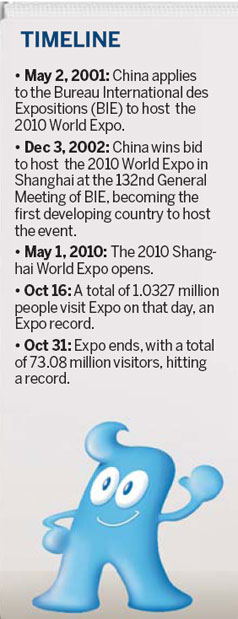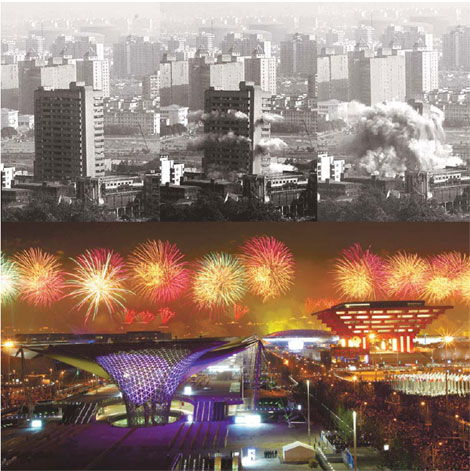Shanghai Expo
Showcase of the world
By Matt Hodges (China Daily)
Updated: 2011-06-01 08:31
 |
Large Medium Small |
|
Top: A 16-story building is flattened in a controlled explosion to make way for the World Expo 2010 in Shanghai on Nov 8, 2006. Above: The 5.28-sq km Expo Garden received a total of 73.08 million visitors. Top: Provided to China Daily; above: Niu Yixin / For China Daily |
Before last year's Shanghai World Expo, Beijing Zoo was known for its endangered indigenous species: giant pandas, Siberian tigers and the Tibetan gazelle. Pretty soon it may include another beast altogether: flying men from Latvia ricocheting around vertical wind tunnels.
Further south, the coastal city of Qingdao, Shandong province, is shaping up as a new center for the promotion of Belgian diamonds, chocolates and beer, as one Chinese group plans to rebuild the Belgium-EU Pavilion there. Meanwhile, merchants in southern Fujian province are piecing together a virtual Expo playground around a rebuilt Australia Pavilion.
"People seem to be keen to keep a memory," says Peter Sams, director of the hugely popular Australia Pavilion, which welcomed 8.2 million visitors from May 1 to Oct 31 last year.
These are just some examples of how the 2010 Expo served as a gigantic matchmaking session for China and the rest of the world. "This was the largest event in the last 38 years of China's history," according to Vincent Gonzales Loscertales, secretary general of the Bureau of International Expositions (BIE), the governing body of World Expos.
"The other big event was the (2008 Beijing) Olympic Games, which was also an excellent branding opportunity for the country, but it attracted less than 1 million people. In contrast, we ran for six months and helped build an engine for China's international relations," he says.
For Sams, a key indicator of the Expo's success is the relevance and snowballing interest in its theme.
"There is no way this Expo has not had a major impact on raising awareness in China of important social and environmental issues," he says. "It's in the air now. Lots of people are talking about 'Better City, Better Life'."
Shanghai splurged an estimated 28.6 billion yuan (3.2 billion euros) in hosting the first World Expo in a developing country. It welcomed 242 countries, regions and international organizations with new subway lines and a citywide facelift. This included a social campaign to brush up city residents' manners and encourage them to smile more, rather than elbowing their way to the front of the nearest line.

"What surprised me most at first were the sheer numbers," says Roberts Stafeckis, commissioner-general of the Latvia Pavilion. "We were at the Hanover Expo in Germany 10 years ago, but in Shanghai everything was three to five times bigger."
The event broke scores of records and left a lasting impression on a population of 1.35 billion people. It welcomed 73 million visitors, 95 percent of them Chinese, over six months to its aggregate 3.28-km site on either side of the Huangpu River.
There is little doubt that the Shanghai Expo exceeded all expectations. At the closing ceremony on Oct 31, BIE President Jean-Pierre Lafon hailed it as an "outstanding success". UN Secretary-General Ban Ki-moon said it "offered hope for tackling the growing challenges of our urbanized age", and Premier Wen Jiabao said it gave the Chinese public "a good opportunity to learn from the world".
"One day in the Expo is more rewarding than 10 years' reading," he said.
On the same day, at a specially convened Summit Forum, Expo organizers presented the "Shanghai Declaration", a manifesto that serves as part of the intellectual legacy of the event. In it, participating countries, regions, officials and academics vowed to keep working together on common issues such as climate change and problems of urbanization.
One year after the opening of the largest World Expo to date, construction materials and rented properties have been officially handed back to the city of Shanghai, paving the way for what some believe will become a new CBD or business heartland in China's financial hub.
"The Shanghai Expo will be difficult to repeat," says Loscertales. "The lessons we need to learn are that the Chinese government took the Expo seriously, and they used it as a catalyst for urban development, as an important element of foreign policy, as an important element of branding, and for the elevation of the citizens."
The exercises in bridge building have for many only just begun. Sweden, for example, allocated an Expo budget of 15 million euros, the largest branding exercise ever undertaken by its government and business community, in order to raise its profile.
Many of the other 45 European countries that pitched up - most chose to attend despite the crippling financial crisis, even if it meant slashing their original budgets - felt the same way. Norway got to sell itself as a tourist and investment destination; Italy forged goodwill with the Chinese people by flying over Ferraris and Ferragamo shoe designers; and Greece closed scores of business deals with China while helping its corporate sponsors build invaluable guanxi (relationships) with prospective clients and customers.
The UK built a national pavilion featuring 60,000 seed-bearing acrylic rods as part of a project to create a world biodiversity bank in partnership with botanical gardens in London and Kunming, Yunnan province. Its pavilion entertained 8 million visitors and 140 trade and investment events.
In fact, much has changed since the days before the Expo arrived in town.
Of the multitude of pavilions that coalesced into a fantastic landscape that was bewildering to behold, only a few remain. Where once stood a makeshift global city unrivaled in scope and imagination, featuring the latest innovations in energy-saving technology and green dreams, there now stands just a palimpsest, but one with endless promise.
The multi-million-euro Expo Axis has not been dismantled. Its walkways and sunlight-funneling wind funnels are likely to be developed into a new shopping and entertainment hub. The China Pavilion, Theme Pavilion, Expo Center and Performance Center are also here to stay, as is much of the Urban Best Practices Area, an exciting new feature to the World Expo that allows dozens of world cities to exhibit their innovations to the world.
However, one of the lasting legacies of the 2010 Expo is undoubtedly the new Expo Museum. Anecdotally, the treasures will include a popular statue that served as the main exhibit of the European microstate of San Marino.
"We donated this as a gift because we wanted to say thank you to the organizers for giving us space in one of the shared pavilions," says Davide Righi, deputy director of the pavilion, who is now setting up a representative office in Shanghai on behalf of his republic of 30,000 people.
(China Daily 06/01/2011 page66)
| 分享按钮 |
